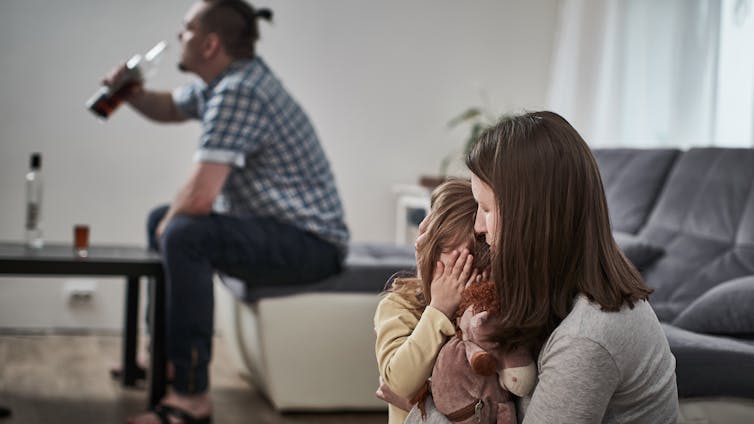
At least three decades of research on the intersection of substance use with domestic and family violence consistently shows the frequency, severity and impact of violence increases in the context of the perpetrator using alcohol and other drugs.
Some 24–54% of domestic and family violence incidents reported to police in Australia are classified as alcohol-related, while other drugs are implicated in 1–9% of incidents. This is consistent with international evidence which shows substance use occurs with domestic and family violence in 25–50% of cases.
Several studies have also pointed to the increased severity of domestic and family violence when substances are involved. An Australian study, which looked at 240 women murdered by a current or former male partner between 2010 and 2018, reports more than 60% of the male perpetrators were affected by alcohol or drugs during the fatal episode.
Other research indicates alcohol-related domestic and family violence is two to three times more likely to involve severe physical violence such as life-threatening injuries and broken bones, compared to domestic and family violence where alcohol is not involved.
Our research, however, is interested specifically in the role alcohol and other drugs play in perpetrators’ tactics of violence and abuse. This is sometimes called “substance use coercion” and is a type of coercive control.
Understanding substance use coercion
Coercive control is a repeated pattern of emotional, verbal, sexual, financial or technology-enabled abuse that creates fear and exerts control over another person.
A set of national principles seeking to address coercive control in family and domestic violence recognise that substance use can be exploited in the same way as technology or financial abuse.
Our work identifies several ways perpetrators may use alcohol or other drugs as a form of coercive control, or, in other words, exploit their own substance use to gain more power. These include:
to excuse their violence (“The drink made me do it”)
to shift the focus from their abuse to other issues (“I have a drug problem, that’s more important”)
to control others through their substance use. For example, when a person using violence is intoxicated or in withdrawal, victim-survivors often comply with their demands or avoid arguments to de-escalate the violence.
Perpetrators may also weaponise victim-survivors’ substance use. Research shows that, to numb the physical and emotional pain of family violence, victim-survivors may start using substances.
Perpetrators often encourage this practice to increase their power and control over the victim-survivor and to undermine their credibility if authorities become involved.
Likewise, perpetrators may exacerbate victim-survivors’ existing substance use, such as by pressuring them to drink or take drugs more often. Alternatively they might sabotage victim-survivors’ recovery efforts, preventing their access to treatment services.
Another tactic involves lying about the nature and extent of the victim-survivor’s substance use. This can undermine their credibility with authorities such as child protection services or the family court.
Children suffer too
On a basic level, children are terrified when they hear their father come home drunk and abusive. They fear for both themselves and their mothers, often finding the abuse that follows leaves them with neither parent in a position to look after their needs.
They may also be implicated in their father’s substance use coercion. For example:
Unless you shut those kids up, I’m going to drink.
The severe impact on children living with violence where either or both parents are substance-affected can be seen through child protection data.
A recent New South Wales study reported on children living in situations of domestic and family violence. Children where one or both parents had either substance use issues or poor mental health were three times more likely to be identified as at risk of harm warranting statutory intervention, than in cases of domestic and family violence alone.
Children in situations where substance use and domestic and family violence intersect are some of the most vulnerable in Australia.

What can we do?
Policy and practice responses to the intersection of domestic violence and substance use, both in Australia and internationally, have tended to focus on single issues: domestic violence or substance use.
While many families experience domestic violence and substance use as profoundly intertwined, service systems often fragment their experiences, treating the two as disconnected problems.
Our research is exploring how these two highly siloed sectors can work together, in the form of a 17-week group program for fathers who used violence and abuse in the context of substance use. These men had more significant histories of violence and abuse than men in a similar program targeting violence only.
International evidence shows programs that address both substance use and domestic violence are developed but rarely sustained, despite evidence of their effectiveness.
We would like to see more nuanced policy and practice that recognises the complex crossover between domestic and family violence and substance use. Importantly, these approaches must address children’s experiences of these intersecting issues, and provide tailored responses to promote their safety.
The National Sexual Assault, Family and Domestic Violence Counselling Line – 1800 RESPECT (1800 737 732) – is available 24 hours a day, seven days a week for any Australian who has experienced, or is at risk of, family and domestic violence and/or sexual assault.
Cathy Humphreys receives funding from the Australian Research Council, ANROWS and funding from community organisation grants for specific projects.
Margaret Kertesz receives funding from the Australian Research Council, from DV NSW and project-specific funding from some community-based organisations.
Van Callaly receives funding from the Australian Research Council and project specific funding from some community-based organisations.
This article was originally published on The Conversation. Read the original article.







